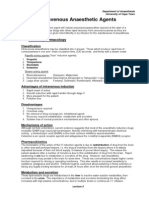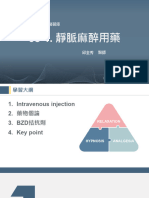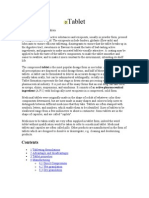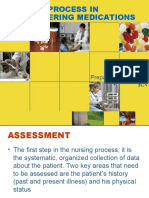Lange Anesthesiology
Lange Anesthesiology
Uploaded by
Bang DizonCopyright:
Available Formats
Lange Anesthesiology
Lange Anesthesiology
Uploaded by
Bang DizonCopyright
Available Formats
Share this document
Did you find this document useful?
Is this content inappropriate?
Copyright:
Available Formats
Lange Anesthesiology
Lange Anesthesiology
Uploaded by
Bang DizonCopyright:
Available Formats
Lange Anesthesiology >
Chapter 8. Nonvolatile Anesthetic Agents
Sections in this chapter:
Key Concepts Nonvolatile Anesthetic Agents: Introduction Pharmacological Principles Pharmacokinetics Pharmacodynamics Specific Nonvolatile Anesthetic Agents Barbiturates Benzodiazepines Opioids Ketamine Etomidate Propofol Droperidol Profiles in Anesthetic Practice Case Discussion: Premedication of the Surgical Patient Suggested Reading
Lange Anesthesiology > Section II. Clinical Pharmacology > Chapter 8. Nonvolatile Anesthetic Agents >
KEY CONCEPTS
As plasma concentration falls, some drug leaves the highly perfused organs to maintain equilibrium. This redistribution from the vessel-rich group is responsible for termination of effect of many anesthetic drugs. For example, awakening from the effects of thiopental is not due to metabolism or excretion but rather to redistribution of the drug from brain to muscle. Nonprotein-bound drugs freely cross from plasma into the glomerular filtrate. The nonionized fraction of drug is reabsorbed in the renal tubules, whereas the ionized portion is excreted in urine. Elimination half-life of a drug is proportional to the volume of distribution and inversely proportional to the rate of clearance. The plasma concentration of a drug with long half-lives may still fall rapidly if distribution accounts for the vast majority of the decline and elimination is a relatively insignificant contributor. Therefore, the rate of clinical recovery from a drug cannot be predicted by its half-lives alone. Repetitive administration of barbiturates saturates the peripheral compartments, so that redistribution cannot occur and the duration of action becomes more dependent on elimination. Barbiturates constrict the cerebral vasculature. This effect may protect the brain from transient episodes of focal ischemia (eg, cerebral embolism) but probably not from global ischemia (eg, cardiac arrest). Although apnea may be less common after benzodiazepine induction than after barbiturate induction, even small intravenous doses of diazepam and midazolam have resulted in respiratory arrest. Ventilation must be monitored in all patients receiving intravenous benzodiazepines, and resuscitation equipment must be immediately available. The accumulation of morphine metabolites (morphine 3-glucuronide and morphine 6glucuronide) in patients with renal failure has been associated with narcosis and ventilatory depression lasting several days. Opioids (particularly fentanyl, sufentanil, and alfentanil) can induce chest wall rigidity
Lange Anesthesiology > Section II. Clinical Pharmacology > Chapter 8. Nonvolatile Anesthetic Agents >
You might also like
- Brain Resuscitation and Protection MutiaraNo ratings yetBrain Resuscitation and Protection Mutiara30 pages
- Lecture On Pharmacology of Anesthetic Drugs: Yizez Mebratu 23APR11No ratings yetLecture On Pharmacology of Anesthetic Drugs: Yizez Mebratu 23APR1190 pages
- Uia 13 DELAYED AWAKENING OR EMERGENCE FROM ANAESTHESIANo ratings yetUia 13 DELAYED AWAKENING OR EMERGENCE FROM ANAESTHESIA3 pages
- Desirable Properties of PSA Pharmacologic AgentsNo ratings yetDesirable Properties of PSA Pharmacologic Agents42 pages
- Medications For Analgesia and Sedation in The Intensive Care Unit: An OverviewNo ratings yetMedications For Analgesia and Sedation in The Intensive Care Unit: An Overview5 pages
- Fentanyl Citrate Injection, USP: RX Only DescriptionNo ratings yetFentanyl Citrate Injection, USP: RX Only Description7 pages
- Pharmacodynamics (Agonists: Mechanisms of Drug Actions)No ratings yetPharmacodynamics (Agonists: Mechanisms of Drug Actions)36 pages
- Evaluation and Management of Delayed Awakening or Emergence From AnaesthesiaNo ratings yetEvaluation and Management of Delayed Awakening or Emergence From Anaesthesia19 pages
- LI Case 2 (Pharmacological Properties of Propanolol)No ratings yetLI Case 2 (Pharmacological Properties of Propanolol)2 pages
- Halcion Triazolam Tablets, USP CIV: DescriptionNo ratings yetHalcion Triazolam Tablets, USP CIV: Description14 pages
- 2015 Anesthesia - A Comprehensive Review, 5ENo ratings yet2015 Anesthesia - A Comprehensive Review, 5E1 page
- RANASINGHE Basic Pharmacology and IV HypnoticsNo ratings yetRANASINGHE Basic Pharmacology and IV Hypnotics34 pages
- Journal Course Evidence Based Use of Nonopioid Analgesics August 2018No ratings yetJournal Course Evidence Based Use of Nonopioid Analgesics August 20187 pages
- Critical Care Medications: Anti-Arrhythmics Study Guide: Critical Care EssentialsFrom EverandCritical Care Medications: Anti-Arrhythmics Study Guide: Critical Care EssentialsNo ratings yet
- Prescription Completeness and Drug Use PatternNo ratings yetPrescription Completeness and Drug Use Pattern7 pages
- Common Disk-Shaped Tablets A Tablet Is A Mixture of ActiveNo ratings yetCommon Disk-Shaped Tablets A Tablet Is A Mixture of Active8 pages
- Physiologically Based Pharmacokinetic ModellingNo ratings yetPhysiologically Based Pharmacokinetic Modelling10 pages
- Nursing Process in Administering MedicationsNo ratings yetNursing Process in Administering Medications37 pages
- Toxicokinetics: Clinical Toxicology 4 Pharm DNo ratings yetToxicokinetics: Clinical Toxicology 4 Pharm D23 pages
- National Institute of Unani Medicine: Kottigepalya, Magadi Main Road, Bangalore-91No ratings yetNational Institute of Unani Medicine: Kottigepalya, Magadi Main Road, Bangalore-916 pages
- Pharmaceutics Sample Paper by Noteskarts Pharmaceutics Sample PaperPDFNo ratings yetPharmaceutics Sample Paper by Noteskarts Pharmaceutics Sample PaperPDF7 pages

























































































